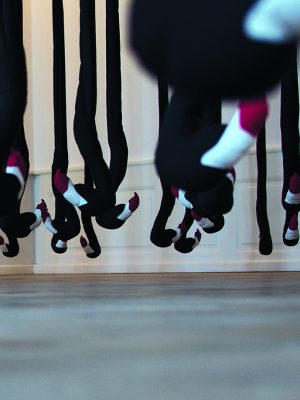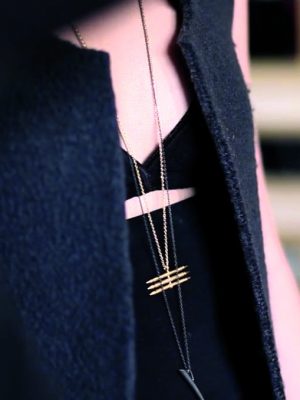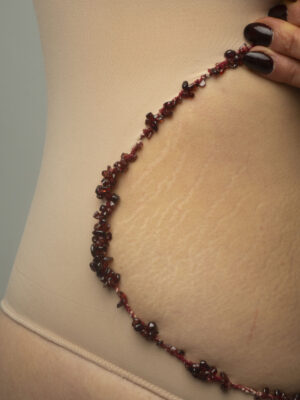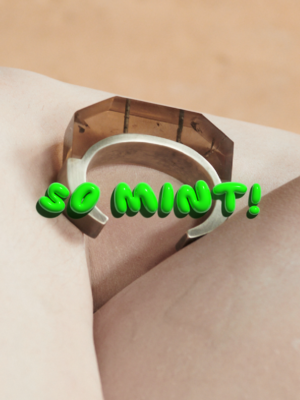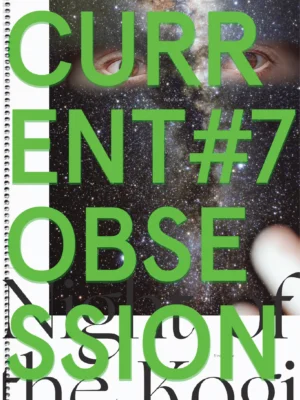‘We cherish to be laidback and sometimes, when we aren’t, we like to appear that way.’ – Danish architect and contemporary jeweller Maja Røhl
We came to Copenhagen in mid-July for a short 5-day visit. The timing was bad, as everyone had gone on vacation. Nevertheless, a lot of people were very kind to come down from their summer houses to meet up and talk. In contemporary Denmark modesty, punctuality and reliability are important aspects of social behavior. People seem to be satisfied and proud of their country’s achievements and also proud of the equality and uniformity in the society. People are happy to be where they are. The brutal Jante Law1 has dissolved and faded, but has remained embedded in the social DNA in a form more subtle and polite. The point here is to avoid envy in others. What if there is an alternative to the value of individual success, the idea of uniqueness and the system of competition encouragement? Maybe the leveled playing field that creates no winners creates no losers. These were some of the things we were trying to discover while spending a few days talking to local artists in Copenhagen.
In the evening of our first day we met up with Jolien Hanemaaijer, a young and talented Dutch designer, who has recently moved to Copenhagen. She took us to a hot hipster pizza place in the Meat District, Kødbyen. Among the first things she mentioned describing Danes were the words ‘cozy’ and ‘laidback’. She told us how casual and equal the relationships seem between the superiors and the subordinates and how easy it feels to work in such atmosphere. The definition of status of this wealthy country surpassed the stages of material success, and in its upgraded state took shape of the abstract notion of ‘laidback-ness’. What does it mean? Apparently, the best way to show off in Denmark is to show how relaxed and laidback you are, regardless of your actual schedule and position.
1 – Jante Law is a concept that points out certain tendencies within the Scandinavian communities that frown upon individual success, ambitions and achievements, considering them inappropriate. General value is shifted towards the overall wellbeing of the community, while discouraging those who stand out as achievers. Ten rules of Jante were fist formulated in a fictional novel ‘A fugitive crosses his tracks’ (En flyktning krysser sitt spor) by the Dano-Norwegian author Aksel Sandemose. The Jante Law is otherwise known as the who-do-you-think-you-are law.
Henrik Vibskov
Making a Twist From The Daily Life
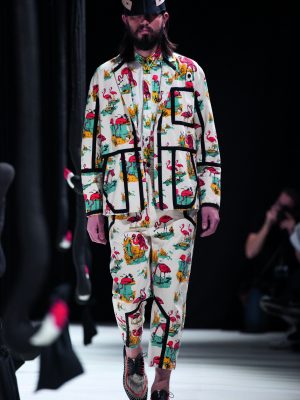
Vibskov opposes the common notion accepted in Scandinavian countries to stick together and not to stick out. He sticks out quite a bit, being not only an avant-garde artist whose distinguished style is recognized all over the world, but as an example of a new generation of ‘multi-makers’ that, we believe, are the future. Interior and theatre design, installation, performance, fashion, music and overall experience are the mediums Vibskov is working with, fluently moving from one to another. He talks about the five senses and how important it is to involve them all when presenting his work. We visited his show NECK PLUS ULTRA at the Gammel Strand Museum and being big fans of his art and his fashion, we felt compelled to write a few lines about this Danish artist extraordinaire. The show, in a surrealist logic or the lack thereof, revolves around the neck. NECK PLUS ULTRA is a pun on the Latin expression nec plus ultra meaning nothing farther beyond and simultaneously a reference to the neck as an anatomic body part, a throat, a tube, a connection between the head and the body. Vibskov’s obsession with a ‘neck motif ’ comes across in different forms throughout the exhibition. One of the most memorable installations is a room filled with black flamingoes hanging upside down. Bizarre black birds, whose necks stretched all the way from the ceiling to the floor, create a weary feeling when inside the room. One has to ‘push’ trough the necks and it is quite impossible to walk through the room without touching them. This work is a reference to a slaughterhouse, as the birds are hanging upside down, but the exoticism of the flamingo birds brings a twisted surreal feel to the place. The neck represents his ‘right-now’ interest and one can bear witness to his working method of creating a twisted universe, a complete fantastic story around a subject, and channeling the expression through art, through performance and through fashion.
‘Maybe I’m the ordinary one. And everybody else is avant-garde… Maybe I think normally, and everybody else operates strangely. They go to work every day at the office. That’s strange.’ – Henrik Vibskov (documentary by Carl Johan Engberg, Stavfel produktion, 2011)
Vibe Harsløf
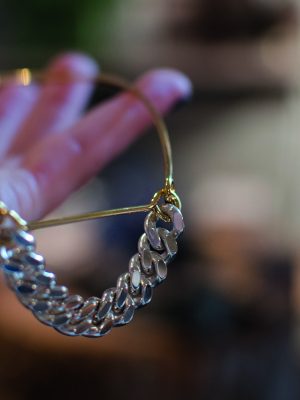
Vibe Harsløf’s jewellery captures urban Scandinavian style, her pieces are very delicate and wearable. She creates a collection every 6 months and shows it at professional fairs in Copenhagen and Paris. Each season Vibe collaborates with a fashion label creating pieces for their fashion show. She graduated 20 years ago, but started to work with two collections a year since 2006. She worked for a large Danish jewellery company Pilgrim, developing a sub-line for them and even after the label was shut down due to economic crisis, she felt like continuing with the same production rhythm, in a more structured way and not randomly producing as before.
‘I don’t know if you noticed, but the Danish girls always wear sneakers. I worked a lot with ankles, I’m into ankles chains, and ankle braces, and ankle anklets and stuff… but it doesn’t make a lot of sense in the winter because you can’t really see them. So I was thinking how can I develop it into something that will work in the winter and will function outdoor, and then I started working on some shoe things.’
Maria Black
Making Superfluous Essential
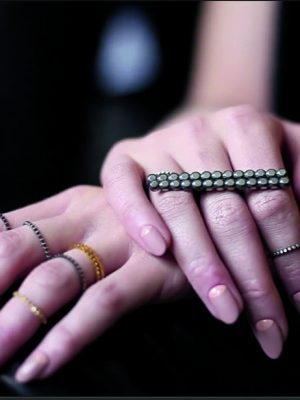
Maria Black is Copenhagen-born fashion jewellery designer currently based in London. We have been following her work on social networks, which are believed to be the place where her designs first gained popularity, tagged by people wearing her jewellery on Facebook and Instagram. Typing #mariablack in Instagram yielded over 3102 results. After her collections had been sold out at a temporary pop-up store during Copenhagen Fashion Week 2012 she decided to open a permanent flagship store in Copenhagen in June 2013: very black and very elegant indeed. Her minimalist approach to jewellery excludes stones and uses metal as the only medium. Concentrated pure and geometric forms, repeated patterns and, what we found most peculiar, the interchangeable pieces compose her signature style. The elements in each collection can be combined in different ways, which activates the possibilities to wear older work. She makes jewellery to adorn a human body in a most observant and intimate way: small rings for upper phalanges, earrings that curl up the earflap, earrings that are hardly visible, yet very sensual, necklaces, which lengths are precisely measured to be worn in multitude…
Her jewellery is a perfect example of ‘good taste’ (a term mentioned by Roland Barthes in the book The language of Fashion) fashion jewellery, where a small object, regardless of its price, or the material it is made of, becomes a vital element to the overall style, a connecting link that ties together the composition. This jewellery makes the outfit emotional and meaningful.
Therese Mørch-Jørgensen
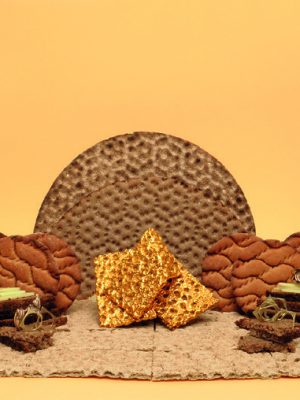
Therese has graduated from the Jewellery Department of RCA, she recently left London and returned back to Copenhagen, where she is currently establishing her practice. Her work focuses on how the quotidian, common, insignificant objects can serve as a means of one’s identity and belonging.
PUTPUT
Making Ordinary Extraordinary
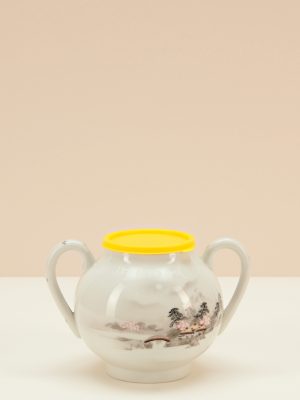
PUTPUT is an upcoming interdisciplinary Swiss/Danish duo currently based in Copenhagen. Ulrik Martin Larsen, the Danish half of the duo (the other half is Stefan Friedli), kindly agreed to meet with us outside a cute coffee shop in the Nørrebro area. He brought a neat box with perfectly arranged prints of their photographic work. The main focus of PUTPUT is the juxtaposition of various recognizable objects that have meaning in contemporary culture and precise interception of that meaning in an endless game of clever interpretations. They are interested in word games: titles like Girl With a Pearl Earring or Clockwork Orange become unexpected and bizarre interpretations, constrained within the boundaries of everyday objects.
‘Turning the ordinary into the extraordinary’ is how Ulrik puts it. The man himself is an obsessive collector. For him the enjoyment of collecting is not about accumulating objects of one type, but rather curating several collections at the same time, until he feels like a certain group is ready to be ‘taken further’. Like taking a pretty sponge that has been lying on his desk for about two years and combining it with a Popsicle stick. Two objects just happened to lie next to each other and one of a sudden the realization dawned on him – he took the stick and pushed it into the sponge. That is how their wellknown Popsicle series was born.
‘I collect sponges everywhere, I have a huge sponge collection… I don’t think it’s necessarily a fascination with collecting as such; it’s more a fascination with the objects and our relationship to the objects. I find it interesting, this metaphysical relationship that you have with something dead, you know, like the meanings you apply to it. I don’t think of these connections being coincidental; I really keep my eyes open and see a connection between things…’
This meticulous and time-consuming approach to making work made us think about jewellery.
‘The project is based on a meticulous research into generic plastic containers and more importantly their often colorful lids and trying to match or pair them with glass and porcelain pots, bowls, vases and glasses. We tried to facilitate a meeting of materials between two related, but quite contrasting objects, which in turn hopefully creates a narrative through combining the two different entities; we imagine a fancy lady on the town sipping her take away martini in a glass with a plastic lid normally used for take away coffee´s. We find the juxtaposition of the plastic lids which are often thought as being cheap throw-away items and the more precious glass and porcelain items interesting, they both fulfill practical demands, but the difference in perceived value of the treasured glass and ceramic items seem to have a bigger threshold for imbedding or attributing emotions and memories, whereas the plastic lids are mostly met with indifference.
The entire research for the project took about 4 months, countless trips to second hand shops with a bag full of assorted plastic lids accompanied by a lot of curios looks from strangers whilst trying on lids on pretty much every household item in the shops, but it was a strangely satisfactory feeling to find the perfect matches and meetings between objects.’
Objects appear complete, but in a rather bizarre way. The final result is an amazing collection of images, where vessels appear reborn, acquired a new character, unknown and unexpected.
Helen Clara Hemsley
Making Streetwise Jewels
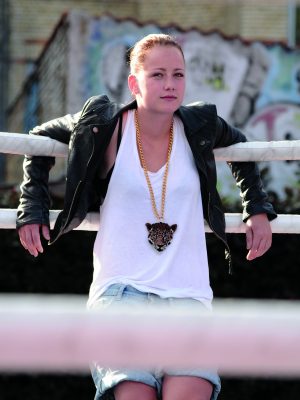
Helen Clara Hemsley (ZA, 1969) trained as a sculptor at the Glasgow School of Art and at the Institute of Fine Metals in Copenhagen. Her passion for small things created debates with teachers who demanded more volume and more dimensionality. She was also interested in performance as a medium, and once, during a live performance she had an epileptic shock because of the soap bar she was holding in her mouth. After that incident she wanted to make something a little more ‘controlled’, so she started making jewellery. Helen is one of the founding teachers at a recently opened school Fabrikken where youth 15–25 years old learn how to work with textile and jewellery, among other things.
Helen is absolutely irresistible; while talking about her work, she completely pulls one into her world. Growing up in Durban, a port city on the east coast of South Africa, she became obsessed with TV series Dynasty and Dallas. Watching rich and fabulous women, ‘trophy wives, whose husbands married them because they look like they do’, all Helen wanted was to be like them.
Her work itself is of the most direct and the most literal kind. The pieces are embroidered, flat, two-sided pendants and brooches. They portray things like faces, cars, continents, animals in a very naïve, very child-like manner. The titles are hilarious and witty: The Grass Is Greener On The Other Side (for a rectangular patch with two shades of green), You can lead a horse to water but you cannot make him drink (for a head of a horse with a leather lead), Give me a call when you like yourself better (for a life-size embroidered iPhone), but they are also very emotional and personal. Helen states things as they are. It is very interesting that regardless of the work being quite literal and, one may say, crafty, it has a very prominent contemporary edge to it. It’s like she deals with all these things mentioned above then comes out on the other side with work that is absolutely ‘now’.
The embroidery, no matter how simplistic, has a very interesting and somewhat twisted notion of the ‘other side’. What is the ‘good’ and what is the ‘bad’ side, or what is ‘front’ and what is ‘back’? The idea of making something and all the time looking at its ‘front’, while knowing that you would not be able to avoid dealing with its ‘back’… In the same way Helen’s work has a different side to its naïve appeal: it is the artist, in whose character it is to deal with life’s events, whatever they might be, with courage and humor.
Mette Saabye
Making Impossible Possible
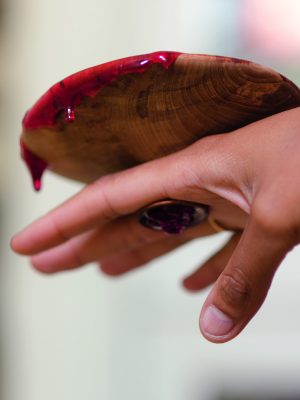
Mette Saabye is the mother figure in the Copenhagen contemporary jewellery scene. Her studio in a vibrant Latin Quarter of Copenhagen exists on its current location since 2005 and seems to be the meeting point for a lot of local jewellers. It is entirely covered with gold leaf and literally glowing form the inside. Mette shares her studio with two other jewellers: Josefine Rønsholt Smith and Louise Bech. She is a woman of a quite unusual character for a Dane. She is very confident and the typical Danish modesty transforms in her into more outspoken, willful and focused character. Due to her personality, it seems, she draws a lot of people close to her and serves as a center of gravity for the community. She realizes this part of her personality and carries it with responsibility, doing things like organizing international events, which try to draw more attention to Danish contemporary jewellery scene. Or was it to draw the attention of the Danish contemporary jewellery scene towards the outside world?
‘All that’s happening is kept here in Denmark, we discuss at the seminars that we should try to go more abroad and take action ourselves… Denmark is a weird country, you can make a good living and you can make things work out ok… so in a way many people don’t really see the point in going abroad… they don’treally see the whole idea of developing intellectually and getting a network outside of Denmark, I think it becomes a kind of inbreeding… I really love my field and I think it is a pity that we are ending up left behind. I think there is a lot of talent and we could be much more a part of the international scene… and I think it’s just dull that people stay in their own nest… comfort zone. While I was growing up I was taught that it was a good thing to look for more information and knowledge and try to be curious and try to learn from it… And maybe it would give you an idea if what you are doing were the right thing. You know, having this discussion is also about becoming more focused on what you are doing and why you are doing it.’
Mette is a revolutionary in her own right. She wants to show that jewellery can be much more, and she interprets it in her personal work as well. Her latest obsession is with the process of condensation from the prospective of an alchemist, a jeweller and a philosopher. She uses various simplistic shapes that vaguely remind one of tools, utensils, cups, handles and are generally perceived as such. But they serve a metaphysical purpose. They portray the process of material transformation, where, for example, red glossy resin ‘goes’ into one side of the piece and ‘comes out’ as a precious stone from the other side. Mette cleverly plays with the perceptions of preciousness and metaphoric understanding of jewellery.
‘I always thought it was interesting to make the impossible possible. I think you should have this dream in your life, you should believe you can do things although everyone says it’s impossible. I like to pass this idea onto others, so they see it is possible to make the impossible…’
This article was first published in the #2 Youth Issue of Current Obsession Magazine, 2013

